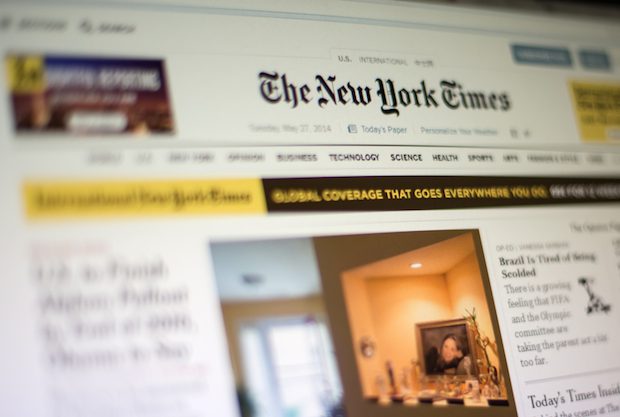Why the New York Times Won’t Show Muhammad

A thousand years before the murder of the cartoonists at Charlie Hebdo, Muslims began to tell stories about unbelievers who possessed and displayed images of Muhammad. In one such tale, a friend of Muhammad travels to the court of the Emperor Heraclius at Constantinople, where he is shown a wondrous gilded box with many openings. From it, the emperor pulls a sheet of silk with a naked, braided man. He asks his visitor if he recognizes him. “This is Adam, peace be upon him,” he says. Next comes a portrait of a curly-haired Noah, then of a bearded Abraham. Then comes an image of a man that even the emperor does not recognize. The visitor begins to weep as he proclaims, “This is Muhammad, the Prophet of God.”
If Heraclius were an editor at a major news organization today, he wouldn’t risk it. In the wake of the Paris attack, the New York Times, the Associated Press, and all major television networks refused to display Charlie Hebdo’s caricatures of Muhammad. The Times announced that it would not show any depiction of Muhammad at all.
The most commonly cited reason was respect for Muslim religious sensibilities. Dean Baquet, executive editor of the New York Times, said “Let’s not forget the Muslim family in Brooklyn who read us and is offended by any depiction of what he sees as his prophet.” That same week, the Times refused to shows a picture of a respectful statue of Muhammad that once stood atop a Manhattan courthouse out of “deference to Muslims, to whom depictions of the prophet are an affront.”
As gestures of sensitivity go, this one is curiously insensitive to the actual history and variety of Islam. Across cultures and centuries, Islam has displayed a deep and abiding wariness of depicting Muhammad. But this fact has not prevented the illuminators of Persian manuscripts, the artists of Turkish courts, the makers of Algerian postcards and Iranian tchotchkes from producing images of the prophet. The Times will not depict Muhammad, but it is happy to paint Muslims with a broad brush.
This was hardly the first time that Western institutions refused to show any image of Muhammad. In 2009, Yale University Press published a book on the Danish cartoons mocking Muhammad but refused—over the author’s objections—to include any illustrations of them. The editor worried that the “grotesque and insulting” cartoons could lead to violence. So he withheld them—along with Islamic depictions of Muhammad.
Claiming that such decisions are made out of respect for “Muslims” as a class has the curious effect of suggesting that any believers who tolerate images of Muhammad are bad Muslims. It is a familiar accusation. For decades, Western critics of Islam have been describing the “true” face of Islam as unbendingly expansionist, illiberal, and violent. Behind this description lies the assumption that a certain Salafi-Wahhabi branch of Sunni Islam, passing through men like Sayyid Qutb, is somehow the “real” Islam.
This serves certain polemical purposes but blinds us to the history and variety of Islam, to the existence of Shia, Sufi, and Ahmadiyya. No one, perhaps, is more alert to the dangers of such reductions than reporters and editors who pride themselves on nuance. Yet in their refusal to print any image of Muhammad, we see a liberal version of the same reductionism.
If it seems odd that Western liberals would end up being more stringent about images of Muhammad than many Muslims, the irony is increased by their professed commitment to unfettered expression. But the logic of sensitivity, the imperative of avoiding offense, is strangely symbiotic with our absolutism regarding free speech.
Western elites have despaired over distinguishing between blasphemy and prayer, pornography and art—all distinctions they were willing to draw not so long ago. How then can we say that this one depiction of Muhammad is unacceptably pornographic, or unkind (or, more archaically, unchristian) while that one is not? No doubt the editors of the Times fear offending Muslims, but they fear offending the tenets of liberal nonjudgmentalism more.
Having abandoned the admittedly imperfect standards and methods by which we once limited our own speech, we have now outsourced the careful weighing of what is and isn’t appropriate, what can and can’t be said, to others. It is understandable enough. To weigh speech by one’s own lights appears proud and narrow-minded. To weigh it by the lights of others is an act of laudable sensitivity. We flaunt our willingness to do or say anything while offloading to others the necessary burdens of circumspection.
This is why I doubt the usefulness of the calls for more and greater free speech that have echoed in the wake of Charlie Hebdo. The abandonment of any broadly acknowledged and agreed-upon standard for regulating speech has led directly to a system by which speech regulation is made an opaque matter of sensitivity and offense—of who’s punching up and who’s punching down. So long as we refuse to erect a shared standard of values, we invite the imposition of a private, arbitrary, and perhaps much stricter one.
Matthew Schmitz is deputy editor of First Things.